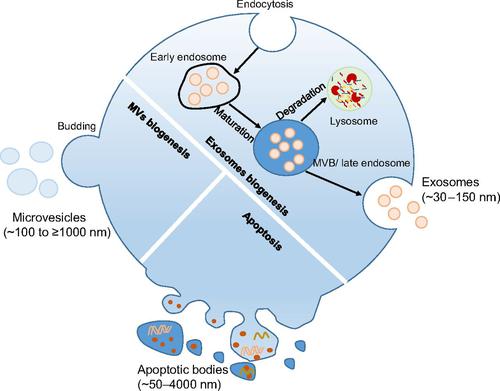当前位置:
X-MOL 学术
›
Pharmacol. Rev.
›
论文详情
Our official English website, www.x-mol.net, welcomes your
feedback! (Note: you will need to create a separate account there.)
Emergence of Extracellular Vesicles as “Liquid Biopsy” for Neurological Disorders: Boom or Bust
Pharmacological Reviews ( IF 19.3 ) Pub Date : 2024-03-01 , DOI: 10.1124/pharmrev.122.000788 Ashish Kumar 1 , Michael A Nader 1 , Gagan Deep 2
Pharmacological Reviews ( IF 19.3 ) Pub Date : 2024-03-01 , DOI: 10.1124/pharmrev.122.000788 Ashish Kumar 1 , Michael A Nader 1 , Gagan Deep 2
Affiliation

|
Extracellular vesicles (EVs) have emerged as an attractive liquid biopsy approach in the diagnosis and prognosis of multiple diseases and disorders. The feasibility of enriching specific subpopulations of EVs from biofluids based on their unique surface markers has opened novel opportunities to gain molecular insight from various tissues and organs, including the brain. Over the past decade, EVs in bodily fluids have been extensively studied for biomarkers associated with various neurological disorders, such as Alzheimer's disease, Parkinson's disease, schizophrenia, bipolar disorder, major depressive disorders, substance use disorders, human immunodeficiency virus–associated neurocognitive disorder, and cancer/treatment-induced neurodegeneration. These studies have focused on the isolation and cargo characterization of either total EVs or brain cells, such as neuron-, astrocyte-, microglia-, oligodendrocyte-, pericyte-, and endothelial-derived EVs from biofluids to achieve early diagnosis and molecular characterization and to predict the treatment and intervention outcomes. The findings of these studies have demonstrated that EVs could serve as a repetitive and less invasive source of valuable molecular information for these neurological disorders, supplementing existing costly neuroimaging techniques and relatively invasive measures, like lumbar puncture. However, the initial excitement surrounding blood-based biomarkers for brain-related diseases has been tempered by challenges, such as lack of central nervous system specificity in EV markers, lengthy protocols, and the absence of standardized procedures for biological sample collection, EV isolation, and characterization. Nevertheless, with rapid advancements in the EV field, supported by improved isolation methods and sensitive assays for cargo characterization, brain cell–derived EVs continue to offer unparallel opportunities with significant translational implications for various neurological disorders.
中文翻译:

细胞外囊泡作为神经系统疾病“液体活检”的出现:繁荣还是萧条
细胞外囊泡(EV)已成为多种疾病和病症的诊断和预后中有吸引力的液体活检方法。基于其独特的表面标记从生物流体中丰富 EV 的特定亚群的可行性为从包括大脑在内的各种组织和器官获得分子洞察提供了新的机会。在过去的十年中,体液中的 EV 已被广泛研究为与各种神经系统疾病相关的生物标志物,例如阿尔茨海默病、帕金森病、精神分裂症、双相情感障碍、重度抑郁症、药物滥用障碍、人类免疫缺陷病毒相关的神经认知障碍、和癌症/治疗引起的神经变性。这些研究重点关注生物流体中总 EV 或脑细胞(例如神经元、星形胶质细胞、小胶质细胞、少突胶质细胞、周细胞和内皮细胞)的分离和货物表征,以实现早期诊断和分子表征,以及预测治疗和干预结果。这些研究结果表明,EV 可以作为这些神经系统疾病的有价值分子信息的重复性且侵入性较小的来源,补充现有昂贵的神经影像技术和相对侵入性的措施(如腰椎穿刺)。然而,围绕脑相关疾病的血液生物标志物最初的兴奋已被挑战所冲淡,例如 EV 标志物缺乏中枢神经系统特异性、冗长的方案以及缺乏生物样本采集、EV 分离、和表征。 然而,随着 EV 领域的快速发展,在改进的分离方法和货物表征的敏感分析的支持下,脑细胞衍生的 EV 继续提供无与伦比的机会,对各种神经系统疾病具有重大的转化意义。
更新日期:2024-02-14
中文翻译:

细胞外囊泡作为神经系统疾病“液体活检”的出现:繁荣还是萧条
细胞外囊泡(EV)已成为多种疾病和病症的诊断和预后中有吸引力的液体活检方法。基于其独特的表面标记从生物流体中丰富 EV 的特定亚群的可行性为从包括大脑在内的各种组织和器官获得分子洞察提供了新的机会。在过去的十年中,体液中的 EV 已被广泛研究为与各种神经系统疾病相关的生物标志物,例如阿尔茨海默病、帕金森病、精神分裂症、双相情感障碍、重度抑郁症、药物滥用障碍、人类免疫缺陷病毒相关的神经认知障碍、和癌症/治疗引起的神经变性。这些研究重点关注生物流体中总 EV 或脑细胞(例如神经元、星形胶质细胞、小胶质细胞、少突胶质细胞、周细胞和内皮细胞)的分离和货物表征,以实现早期诊断和分子表征,以及预测治疗和干预结果。这些研究结果表明,EV 可以作为这些神经系统疾病的有价值分子信息的重复性且侵入性较小的来源,补充现有昂贵的神经影像技术和相对侵入性的措施(如腰椎穿刺)。然而,围绕脑相关疾病的血液生物标志物最初的兴奋已被挑战所冲淡,例如 EV 标志物缺乏中枢神经系统特异性、冗长的方案以及缺乏生物样本采集、EV 分离、和表征。 然而,随着 EV 领域的快速发展,在改进的分离方法和货物表征的敏感分析的支持下,脑细胞衍生的 EV 继续提供无与伦比的机会,对各种神经系统疾病具有重大的转化意义。






























 京公网安备 11010802027423号
京公网安备 11010802027423号